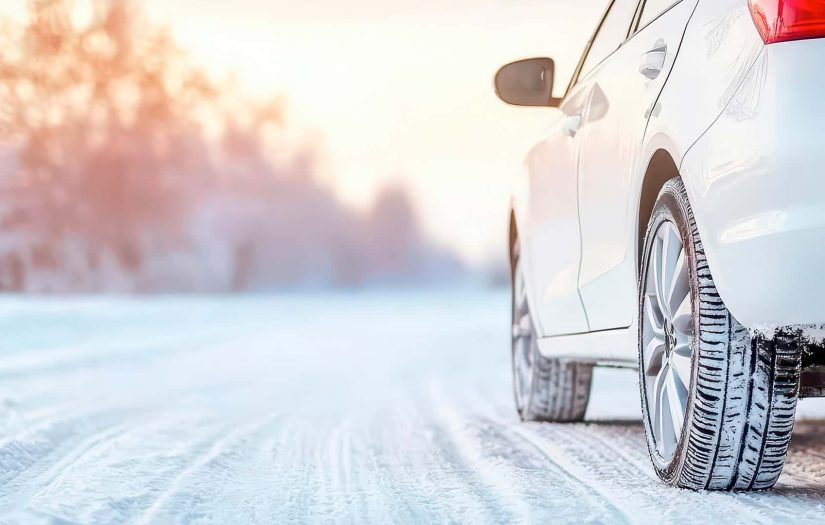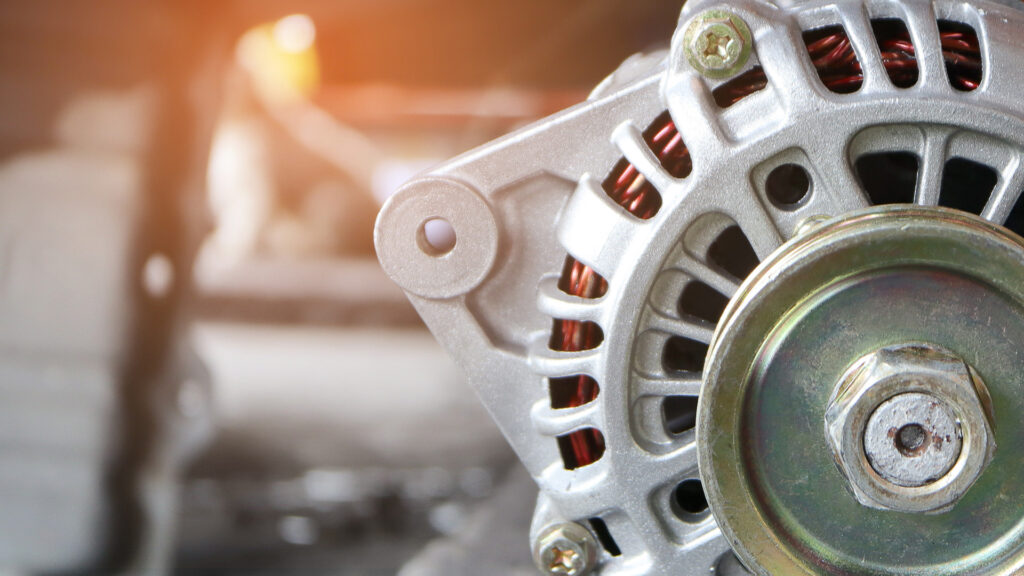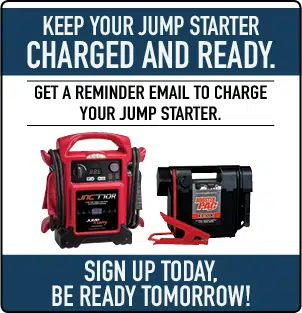We spend a fair amount of time obsessing about the weather here at Clore and within the pages of this blog. There’s good reason for that. Weather can have an enormous impact on battery performance and useful life. Summer heat can be very damaging to batteries, depending on how high it gets and for how long. Just ask anyone who lives in Phoenix or Las Vegas how long they expect their vehicle battery to last and contrast their answer with that of someone living in Northern Michigan. Similarly, winter cold exposes battery weakness – a problem battery is really going to reveal itself if you are in the midst of a serious cold stretch in upstate New York. So, as you can imagine, this time of year, our thoughts turn to the dropping mercury and how our customers can avoid some of the problems that are brought on by the cold winds of December and January. With that in mind, here are our top five tips for beating old man winter when it comes to your vehicle.
Tip #1 – Invest in a Quality Jump Starter
“Of course,” you’ll say, “We knew you’d start with this.” It’s true that this advice is in our (Clore Automotive’s) interest. But, it’s in your best interest as well, dear reader. Possessing a quality jump starter is the number one way to be prepared for vehicle surprises stemming from weather, battery age or other culprits. It enables you to have control over your situation, avoids becoming dependent on others (as is the case with jumper cables), eliminates the possibility of a long wait for help from your auto club or other roadside assistance resource and can turn a major setback into a tiny blip on the radar screen. It’s that helpful.
There are a few ways to make sure that this step works in your favor. First, note that we say “quality” jump starter. If you invest in such a piece of equipment, you want to be sure it is going to answer the call when it’s needed. This is particularly true in the winter. Like your vehicle’s battery, a jump starter’s capacity is reduced as it gets colder and colder. This is true whether the jump starter has a traditional lead acid AGM battery or a lithium battery. So, it better have plenty of power when it’s 70˚F outside or it won’t be much use to you or your vehicle when it’s -10˚F. Booster PAC and Jump-N-Carry jump starters are world-renown for their massive power delivery, reliability and cold weather performance. Whether it’s an ES5000, JNC770 or a JNC345, we hear from customers all the time about how they overcame crazy cold and snow situations using our units.
Lastly, there are a few things to keep in mind as you arm yourself for winter with your trusty jump starter. Foremost among these is to make sure it’s charged. It’s not going to be much use to you if it’s State of Charge (SoC) is too low to be of help. So, if a serious cold snap is on its way, give it a charge. Overnight will usually be plenty. We suggest letting it come up to room temperature prior to charging. Lithium batteries must be above 32˚F to be charged or the Battery Management System (BMS) built inside the battery will likely prevent charging from occurring. Also, it you are expecting a stretch of crazy cold weather (overnight lows below -15˚F), it’s not a bad idea to bring your jump starter in for the night. This way, if your vehicle battery isn’t up to the task in the frigid morning, your jump starter will be.
Tip #2a – Adopt a Preventive Charging Routine for Your Battery
We have addressed this topic previously in a general sense, with less focus on the weather, but the benefits here are exponentially greater as winter rolls around. Periodic charging of your vehicle batteries using a quality battery charger is very beneficial, as it addresses and mitigates many of the potential negative impacts that modern vehicle designs and certain driving patterns can have on your battery.
Modern vehicles place a tremendous burden on the battery within the overall electrical system design. Vehicles are complex, with as many as 80-100 electronic modules controlling specific vehicle functions, all with energy demands. There are more creature comforts within the cabin – heated seats, ventilated seats, self-dimming mirrors, large LCD screens – that consume vastly greater power than vehicle cabins of 20 years ago. All of the electrical/electronic loads add up to stress on the battery. Plus, short trip driving and other driving patterns place extra stress on battery health. Periodic preventive charging counteracts this stress and ensures that your vehicle’s battery gets a beneficial, full charge back to a 100% SoC. This can have very positive impact on overall battery life.
As we noted at the start of this article, winter cold reveals battery weakness and underlying issues. One way to help your battery avoid giving up the ghost during cold spells is by instituting a charging regimen. Again, like your jump starter, an overnight charge should be all it takes to give your battery a good, full charge. Between setting up the charger, starting the charge routine and then disconnecting the charger in the morning, it might take 10 minutes for each vehicle you own. The payback for those 10 minutes is huge.
Our PRO-LOGIX PL2320 is a perfect charger for this task. It runs an advanced multi-phase charge routine to beneficially bring batteries to full charge, restoring reserve capacity and extending battery life. It offers 20A, 10A and 2A charge rates, so can be used on batteries of all sizes. It can properly charge Flooded, AGM, Spiral Wound, Deep Cycle and Marine lead acid batteries as well as LiFePO4 lithium batteries. It features temperature compensation, which is ideal when charging in a cold garage and it even has a Battery Repair Mode that automatically kicks in if it senses signs of sulfation in the connected battery
Tip #2b – Consider an Overnight Charging Strategy
This one is particularly applicable in areas that experience extreme cold. It is also particularly appropriate for fleets, whether they are passenger vehicle fleets or heavy-duty fleets. Consistent overnight charging can be very helpful during periods of extreme cold. This provides two benefits: first, it addresses everything covered in Tip #2a above; second, it makes sure that your battery is ready for service and warm when it’s time to start your vehicle the next morning. So, if you have a municipal fleet of squad cars, ambulances or work trucks in a very cold part of the US or Canada, this strategy could make a lot of sense for you.
For sure, the ideal unit for such a task is our 12V 1.5A Underhood Battery Charger/Maintainer, Model 1002. The 1002 is designed to be permanently mounted on the vehicle battery and utilizes a short input cord that gets connected to an extension cord. There are no buttons to press or options to choose – simply connect it to power and it goes to work. Like the PL2320 above, it executes a multi-phase charging process and features temperature compensation. It properly services a variety of lead acid battery types, including Flooded, AGM, Spiral Wound, Deep Cycle and Marine batteries.
Tip #3 – Check Your Batteries at the Start of the Cold Season
This is another topic we have covered separately and one that is very worthwhile to keep in mind. If your battery is compromised, it is far better to know it before you are caught in a bad situation. Yes, with Tip #1 above, you’d likely overcome the issue and render it a minor inconvenience, but it’s still better to know in advance. The reality is that you’re going to have to replace a deteriorating battery soon (either proactively or in response to a future battery failure), so better to know and be able to plan for it (both in terms of budget and time spent to address it). Plus, we all know that a failure, if it came to that, never happens at a convenient moment.
Deploying a basic electronic battery tester is quick and easy and provides serious peace of mind. Our Model BA9, 12V Digital Battery and System Tester, is simple to use, walking the operator through the testing steps. It can test Flooded, AGM, Spiral Wound, Gel Cell, Stary-Stop AGM and Start-Stop EFB batteries. The testing process takes less than five minutes total and provides very clear picture of battery health, offering a numerical test result (such as tested CCA capacity of the battery), a pass/fail judgement, State of Health (SoH) assessment and State of Charge (SoC) assessment. If you aren’t in the market for a tester at this time, make sure that your service shop runs a battery test each time you are in for an oil change.
Tip #4 – Check Your Electrical System at the Start of the Cold Season
This one is related to Step #3 above, but is also it’s own effort. The way modern non-BEV passenger vehicles are designed, your electrical system is like a stool with three legs: the battery, the starter and the alternator. Each of these three components needs to be working properly for the system to operate efficiently and effectively as a whole. If any single component is compromised, it places greater stress on the other two, particularly when the cold weather sets in. Again, cold soaking during a freezing spell uncovers weaknesses in system components, just like it does the battery.
Like Step #3 above, the easy answer here is a digital battery and system tester like our Model BA9. Beyond doing a battery test, it is capable of assessing your starting system (starter + battery during the starting event) and assessing your charging output, both without and under loads, to get a very good read on charging effectiveness.
Tip #5 – Be Ready for the Worst
Despite all of the above planning, things can still go wrong. After all, there’s a much more to the process than your vehicle’s electrical system. If you expect to be traveling (or even crossing town) in extreme conditions, it’s best to take the steps we are all reminded of this time of year. Have a blanket or two in your vehicle, have some drinkable water and a bit of food, make sure you have proper jackets/gloves/boots, and keep an eye on the forecast.
Another very handy item to have with you in these situations is a rechargeable LED light, such as our Model LNC330. This great item is a dual-purpose work light/torch light. It provides up to 400 lumen output, can change modes with the click of a button and can run for hours on a full charge. It even features a warning beacon red work light mode that can be used similarly to a flare in roadside situations. Just mount it to your vehicle using its magnetic mount and you will be more visible, whether on the shoulder of a highway or in a busy part of downtown. People will see you and know to slow down and/or move over to give you space.
Avoiding the Winter Blues
Taking some or many of the steps above can help you and your vehicle(s) avoid the winter blues. Most of the above steps fall into the Once of Prevention… bucket, but the good news is that none of them, individually, takes very long to do and many of them would pay for themselves, often many times over. A quality jump starter could save one or more tows. Regular preventive charging can extend battery life by as much as 2-3 years per battery. It’s hard to put a dollar value on avoiding a major disruption when you need to get the kids to school, but you get the idea. Also, the above steps don’t need to be done all at once. They could be implemented over time, as your budget and your bandwidth allow.
We hope that you get some value from these tips. Winter plus people plus driving doesn’t always equal good times, but you can gain a level of control over your situation by following the above tips. Do you have any tips you’d like to share with the community related to your winter vehicle preparation strategies? Have you ever experienced a crazy winter vehicle moment? We are sure your fellow readers would love to hear them. Please share in the comments below.











One Response
Very useful, even for Southeast Texas.
Thank you,
Kirk Lockwood